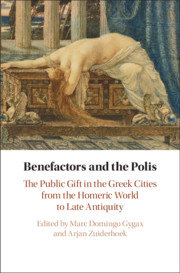 Benefactors and the Polis
Benefactors and the Polis from Part II - Classical Benefactors
Published online by Cambridge University Press: 21 January 2021
Athens represents a special case in the history of Greek public benefactions. It is probably the polis that most resisted the emergence of civic euergetism, that is, the establishment of an organized exchange of benefactions for honors between polis and citizens. At the same time, no other classical polis contributed so much to the development of the practice and to its transformation into a defining institution of the Hellenistic age. This chapter examines these two sides of the history of Athenian euergetism in order to explain the widespread integration of citizens into an institution born before the classical period to regulate the relationship between poleis and foreigners. It deals with the reasons for the opposition to donations and honors for citizens, the factors that contributed to overcoming resistance to euergetism, and the elitist content of classical civic euergetism. Finally, it discusses some developments that counterbalanced this elitist component: the ‘democratization’ of euergetism through grants of honors to non-wealthy citizens, the organization of epidoseis, and other measures that served to prevent the rise of a class of great financial benefactors, along with the relaxation of this policy in the time of Lycurgus.
To save this book to your Kindle, first ensure [email protected] is added to your Approved Personal Document E-mail List under your Personal Document Settings on the Manage Your Content and Devices page of your Amazon account. Then enter the ‘name’ part of your Kindle email address below. Find out more about saving to your Kindle.
Note you can select to save to either the @free.kindle.com or @kindle.com variations. ‘@free.kindle.com’ emails are free but can only be saved to your device when it is connected to wi-fi. ‘@kindle.com’ emails can be delivered even when you are not connected to wi-fi, but note that service fees apply.
Find out more about the Kindle Personal Document Service.
To save content items to your account, please confirm that you agree to abide by our usage policies. If this is the first time you use this feature, you will be asked to authorise Cambridge Core to connect with your account. Find out more about saving content to Dropbox.
To save content items to your account, please confirm that you agree to abide by our usage policies. If this is the first time you use this feature, you will be asked to authorise Cambridge Core to connect with your account. Find out more about saving content to Google Drive.